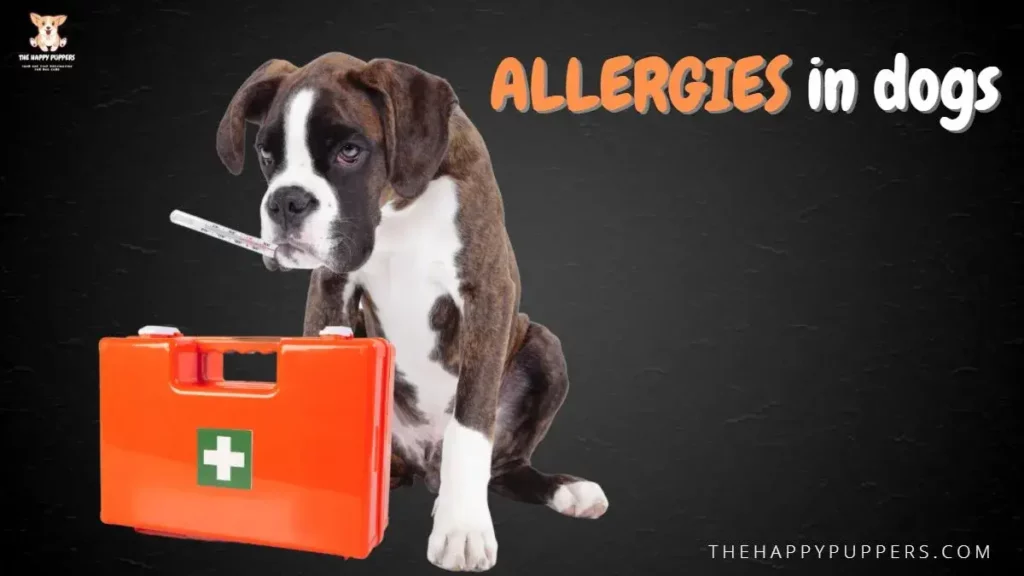Topics covered in this blog post
Signs of allergy in dogs and the treatments
Allergy is very common in dogs. It has been observed that approximately 1-2% of all dogs suffer from some kind of food allergy. 25% of dogs with food allergy also show associated skin ailments.
When dogs come into contact with common environmental allergens like pollen or flea allergen, the proportion of the canine population suffering from allergies drastically increases.
What is allergy ?
Allergy is defined as a state of hypersensitivity or over-reactivity to common environmental pathogens. The pathogens which cause allergy are referred to as allergens. Most known allergens are plant, animal, insect or food proteins.
In dogs as well as humans the immune system is normally responsible for providing protection against diseases. However, in case of allergies, the immune system goes into hyper drive and harms the body.
Immune response to allergies
When an allergen enters the body , the allergen molecule binds to the antibodies present in blood. This allergen-antibody complex then binds to receptors on mast cells. On reaction with mast cells, the mast cells undergo rupture releasing then internal contents like histamines into the blood. These histamines then cause common allergy symptoms like redness, itching. swelling etc.
Are allergies common in dogs?
Yes allergies are a pretty common condition affecting most dog breeds. Most dogs begin to show the signs and symptoms of allergies by the time they are 6 months old.
Is this condition inherited?
Some of the allergies are inherited, like allergy against pollen grain.
 |
| Dogs suffer from multiple types of allergies |
How to discover if your pup has allergy problems?
There are a myriad of diseases which can cause symptoms similar to that of allergy in dogs.. Thus, it will be the best option to trust your veterinarian for the purpose of diagnosing the real cause of the ailment.
What you can do as a dog guardian is to consult your vet as soon as possible if you identify signs and symptoms of allergy and to report the symptoms precisely to the veterinarian upon consultation.
Let’s talk about the different types of allergy which can affect your dog
Allergies are mainly classified on the basis of the following : –
-
On the basis of the type of allergens :
Food allergy, flea allergy.
-
Route of allergen entry:
Food allergy, skin contact allergy or inhalant allergy.
-
Time taken by immune system to respond to the allergen:
Immediate type hypersensitivity: – shock/ anaphylaxis.
Delayed type hypersensitivity
-
Clinical signs of the allergy:
Allergic dermatitis or allergic bronchitis.
-
Mode of inheritance :
Seasonal allergies or atopy.
Let’s dive into the details about the different types of allergy in dogs:-
1. Flea or insect bite allergy:
This type of allergy involves excessive and harmful immune response towards a sting or insect bite. Such allergic reactions in dogs are mostly caused by arachnids (spiders and ticks) and insects like ants, bees, horseflies, deerflies , fleas etc.
Check out this blog post on Flea infestation in dogs.
The most common insect allergen known to affect dogs is flea saliva. This is referred to as flea allergy dermatitis (FAD). Dogs suffering from FAD will want with severe itching to a single bite. Such dogs may also scratch and remove large tufts of hair from the tail base region. Eventually bacterial infection may develop in the regions of broken skin.
 |
| As a dog guardian one needs to be very careful and vigilant |
2. Inhalant allergy:
The primary known inhalant allergens are grass pollen, tree pollen ( oak, ash etc.), mildew, molds, house dust mites. In most dogs, this kind of allergy manifests as an itchy skin. The dog may rub his/ her face, scratch its under arms or lick feet excessively. Most dogs suffering from inhalant allergy start showing signs between 1-3 years of age. Dogs who are affected will react to several allergens and experience concurrent food or flea allergies. The symptoms of atopy are generally curable but a permanent cure is not yet available.
3. Contact allergy :
This is the least common type of allergy observed in dogs. It is a result of coming in direct contact with allergens like lawn pesticides, carpet or bedding synthetics, wool etc. Contact allergies can develop in your dog against anything and at any age. The most common symptom of this type of allergy is skin irritation and itching at the points of contact. Removal of the allergen mostly, results in resolution of the symptoms .
Signs that your dog is suffering from allergies: –
- He/she is always scratching: –
One of the most common allergy symptoms in both humans and dogs is scratching/ itching. It can vary from mild (the hair coat and skin looks normal in this case) to severe (non-stop scratching leading to loss of fur). In extreme cases , there might be severe hair loss and the underlying skin may begin to appear red in color due to rawness and inflammation. The classic itch centers in the dog’s body are:
- Armpits
- Belly
- Ears
- Paws (mostly the front paws are affected)
- Eyes
- Chest
- Groin
- Anal region
- Mouth.
In case your dog shows itchiness around the lower back, especially near or at the base of the tail, it would be indicative of your dog suffering from flea allergy. In case the allergy is of a persistent nature, the affected regions may start to darken in colors or become hyper-pigmented. The skin may also take on a different color and become odorous.
- The feet of your dog smell like corn chips and your dog is obsessively licking his feet.
Contrary to popular belief that dog feet smell like corn chips, it is actually an indication of bacterial growth. Furthermore; if your dog is constantly licking his/her feet, it is not a grooming habit. It is because their feet are itchy. If your dog is endowed with light colored fur, you might notice that the fur beneath his/her feet has taken on a darker color. This is referred to as fur staining. The fur takes on a darker color due to your dog’s saliva.
How is the classic corn chip smell of dog paws related to allergies?
When your dog is suffering from allergies, over time the immune cells of the body begin to break down the healthy skin barrier on the paws. This breakage allows opportunistic microorganisms like bacteria and yeast (which normally reside on the surface of the paw to dive deeper into the skin and cause infection).
- Your dog is suffering from repeated and chronic ear infections:
It is a common symptom for dogs suffering from allergies to have repeated or persistent ear infections. Similar to the feet, repeated ear infections are also a result of allergies. As mentioned earlier, allergies tend to break down the healthy skin layer allowing opportunistic pathogens to gain entry and cause infections. Dogs who have been suffering from un-diagnosed or untreated allergy issues for a long time may have ears which are thickened and smelly. In extreme cases, the ear infection might even become resistant to antibiotic treatment. Under such conditions, your vet may prescribe surgery to remove the ear canal.
 |
| Pin this article for later |
- Recurring hot spots:
Acute moist dermatitis or hot spots as they are otherwise known are very common in dogs, especially in Saint Bernard, Labradors and Golden Retrievers. Hotspots can either form on their own or be secondary to airy underlying allergy that your dog might be suffering from. In case you notice your dog showing repeated hotspot occurrences, it is definitely time to pay a visit to your vet.
- Your dog is suffering from chronic diarrhea and similar symptoms:
Skin is not the only area which gets affected by allergies. Your dog’s gastrointestinal tract is equally vulnerable to suffer from this condition. The symptoms of GI allergy include:
- Recurrent diarrhea
- Gurgly noises in the gut.
- Increased bowel movements
- Presence of red eyes :
This is a symptom which is rarer compared to others but it definitely should not be ignored. It is rare for allergies to affect the eyes in case of dogs but not unheard of. If a certain part of your dog’s eye is inflamed or if both eyes seem to be affected, consult your vet without delay as allergy might be the underlying cause. This type of condition is known as allergic conjunctivitis. The redness may also be accompanied by pawing at the face or squinting .
- Constant coughing:
If your dog is coughing constantly with a worsening of symptoms post physical exercise, it can be another sign of allergies. This type of ailment is referred to as allergic bronchitis: Overall this condition is observed more often in case of cats but a few cases in dogs have been observed as well.
Treatment for allergy in dogs:
Treatment of allergies in dogs depends on several factors like the length of the allergy season, the extremity of the reaction and the symptoms displayed.
1. Shampoo therapy:
If your dog has an itchy and inflamed skin, bathing him/her regularly with a hypoallergenic shampoo can provide relief and soothe the inflamed and itchy skin. Regular bathing also removes allergens which might be present on the coat and may eventually get absorbed through skin. Some shampoos may also have anti inflammatory ingredients which can be beneficial in case of allergies.
2. Desensitization/hyposensitization therapy:
If the vet is able to identify the specific allergen causing hypersensitivity in your dog, then . desensitization treatment can be administered. This type of treatment involves injecting minuscule amounts of the antigen every week. This repeated dosing re-programmes the immune system to stop recognizing the allergen as foreign. The success rate of this treatment is variable. Around 50% of dogs will show improvement in the clinical signs and symptoms. Around 25% of dogs will experience a reduction in the frequency or amount of corticosteroid usage.
3. Treating food allergies in dogs:
The most common food proteins have been found to be associated with allergies are – beef, chicken, egg, wheat gluten, soy or lamb. The most common clinical signs of food allergy are
- Digestive disorders
- Respiratory problems
- Itching.
Food allergy is not known to respond well to corticosteroid therapy or other kinds of medical interventions. The best way to treat this kind of allergy is to identify the food containing the protein and eliminate it from your dog’s diet. The most precise way of conducting this test is to administer a hypoallergenic diet to your dog for a period of 8-12 weeks. Since it takes 8-12 weeks for all other foods to be eliminated from your dog’s body, thus your dog must be on this diet for this duration. If you observe positive changes in the clinical signs, your vet may recommend a specific diet to be followed.
Conclusion:
The symptoms which are observed in care of allergies in dogs, may be confused with symptoms of other disorders. Alternatively, these symptoms can also occur along with other problems. Thus, you must never try to diagnose the problem yourself. Always go to your veterinarian for consultation and diagnosis. Be ready for your pup to undergo a complete diagnostic check up to eliminate all other causes behind skin problems and itching. In case your pup is diagnosed with allergy. you must follow your veterinarian’s advice to provide comfort to your pup.


2 Comments
Why people still use to read news papers when in this technological globe the whole thing
is existing on net?
I have read your article carefully and I agree with you very much. This has provided a great help for my thesis writing, and I will seriously improve it. However, I don’t know much about a certain place. Can you help me?